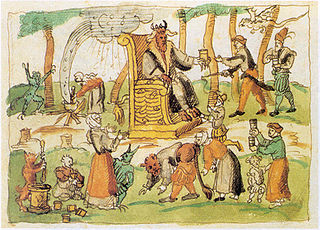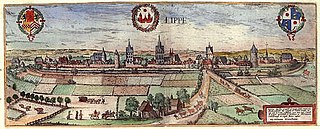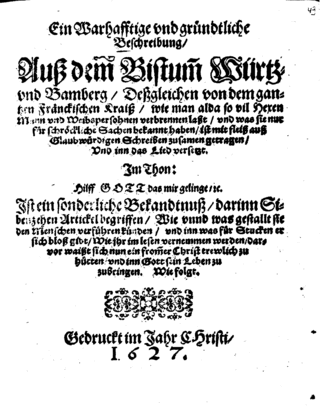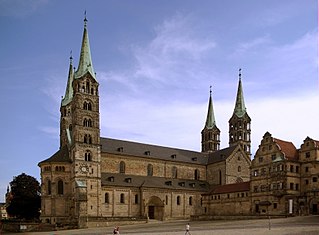
A witch-hunt, or a witch purge, is a search for people who have been labeled witches or a search for evidence of witchcraft. The classical period of witch-hunts in Early Modern Europe and Colonial America took place in the Early Modern period or about 1450 to 1750, spanning the upheavals of the Reformation and the Thirty Years' War, resulting in an estimated 35,000 to 50,000 executions. The last executions of people convicted as witches in Europe took place in the 18th century. In other regions, like Africa and Asia, contemporary witch-hunts have been reported from sub-Saharan Africa and Papua New Guinea, and official legislation against witchcraft is still found in Saudi Arabia and Cameroon today.

A Witches' Sabbath is a purported gathering of those believed to practice witchcraft and other rituals. The phrase became popular in the 20th century.

Anton Praetorius was a German Calvinist pastor who spoke out against the persecution of witches and against torture.

Horb am Neckar is a town in the southwest of the German state of Baden-Württemberg. It is located on the Neckar river, between Offenburg to the west and Tübingen to the east. It has around 25,000 inhabitants, of whom about 6,000 live in the main town of Horb, and the remainder in 18 associated villages and districts which form part of the same municipality. If the entire municipality is counted, it is the largest town in the District of Freudenstadt.

The Würzburg witch trials of 1625–1631, which took place in the self-governing Catholic Prince-Bishopric of Würzburg in the Holy Roman Empire in present-day Germany, formed one of the biggest mass trials and mass executions ever seen in Europe, and one of the largest witch trials in history.

The Basque Witch Trials of the seventeenth century represent the last attempt at rooting out supposed witchcraft from Navarre by the Spanish Inquisition, after a series of episodes erupted during the sixteenth century following the end of military operations in the conquest of Iberian Navarre, until 1524.
Katharina Kepler was a woman from Stuttgart, Württemberg, who was the mother of the famous astronomer Johannes Kepler. She was accused of witchcraft in 1615, but was defended by her son and released.

Werewolf witch trials were witch trials combined with werewolf trials. Belief in werewolves developed parallel to the belief in European witches, in the course of the Late Middle Ages and the Early Modern period. Like the witchcraft trials as a whole, the trial of supposed werewolves emerged in what is now Switzerland during the Valais witch trials in the early 15th century and spread throughout Europe in the 16th, peaking in the 17th and subsiding by the 18th century. The persecution of werewolves and the associated folklore is an integral part of the "witch-hunt" phenomenon, albeit a marginal one, accusations of lycanthropy involved in only a small fraction of witchcraft trials.
Alonso de Salazar Frías has been given the epithet "The Witches’ Advocate" by historians, for his role in establishing the conviction, within the Spanish Inquisition, that accusations against supposed witches were more often rooted in dreams and fantasy than in reality, and the inquisitorial policy that witch accusations and confessions should only be given credence where there was firm, independent, corroborating evidence. He was probably the most influential figure in ensuring that those accused of witchcraft were generally not put to death in seventeenth- and eighteenth-century Spain. The Spanish Inquisition was one of the first institutions in Europe to rule against the death penalty for supposed witches. Its Instructions of 1614, which embodied Salazar's ideas, were influential throughout Catholic Europe.

The Bamberg witch trials of 1627–1632, which took place in the self governing Catholic Prince-Bishopric of Bamberg in the Holy Roman Empire in present-day Germany, is one of the biggest mass trials and mass executions ever seen in Europe, and one of the biggest witch trials in history.
The Channel Islands Witch Trials were a series of witch trials in the Channel Islands of Jersey and Guernsey between 1562 and 1661.
Dorothea Flock, was a German woman convicted of witchcraft in Bamberg and a victim of the Bamberg witch trials during the reign of Prince-Bishop Johann Georg Fuchs von Dornheim.

Rebecca Lemp was a German woman who was accused of witchcraft and burned at the stake in Nördlingen.
Georg Haan was a prominent victim of the Bamberg witch trials.
Witch-hunts are still occurring in Nepal in the twenty-first century, and the persecution of marginalised individuals of the community, especially women, still persists. Witchcraft is believed to be the exercise of supernatural powers by witches. Although Nepal does not have a recorded history of systematic witch-hunts, belief in the supernatural, magic, and humans capable of exploiting both to do good or harm is pervasive. In many instances, witch-hunts are simply tribal scapegoating measures carried out to serve ulterior motives, such as getting revenge or winning property disputes.

Sweden was a country with few witch trials compared to other countries in Europe. In Sweden, about four hundred people were executed for witchcraft prior to the last case in 1704. Most of these cases occurred during a short but intense period; the eight years between 1668 and 1676, when the witch hysteria called Det stora oväsendet took place, causing a large number of witch trials in the country. It is this infamous period of intensive witch hunt that is most well known and explored and given attention.

The witch trials in the Holy Roman Empire, composed of the areas of present-day Germany, Switzerland and Austria, were the most extensive in Europe and in the world, both to the extent of the witch trials as such as well as to the number of executions.

The Witch trials in Denmark are poorly documented, with the exception of the region of Jylland in the 1609–1687 period. The most intense period in the Danish witchcraft persecutions was the great witch hunt of 1617-1625, when most executions took place, which was affected by a new witchcraft act introduced in 1617.
Karen Roeds, was a Danish woman who was executed for witchcraft. She was one of the victims of the great Danish witch hunt of 1617–1625, and a typical example of those accused; almost all of the characteristics of her trial were typical of the trials during the witch hunt of 1617-1625.
The Rottenburg witch trials was a series of witch trials taking place in Rottenburg am Neckar in then Further Austria in present day Baden-Württemberg in Germany between 1578 and 1609. It resulted in the death of 150 people. The witch trials were divided in the waves of 1578-1585, 1589-90, 1595-96, 1598-1605 and 1609. The high peak of the trials were the witch trial of 1595-96, when 41 women were burnt alive at the stake between June 1595 and July 1596. Rottenburg were known as a witch trials center and the 1595 trial attracted attention from the University of Tübingen. The Rottenburg witch trials has been characterized as traditional, since the victims were almost exclusively poor old women, and never developed in to the endemic mass trials in which citizens of all sexes and classes could be indiscriminately accused, such as the Würzburg witch trials, and they were conducted under strict control from the authorities.











